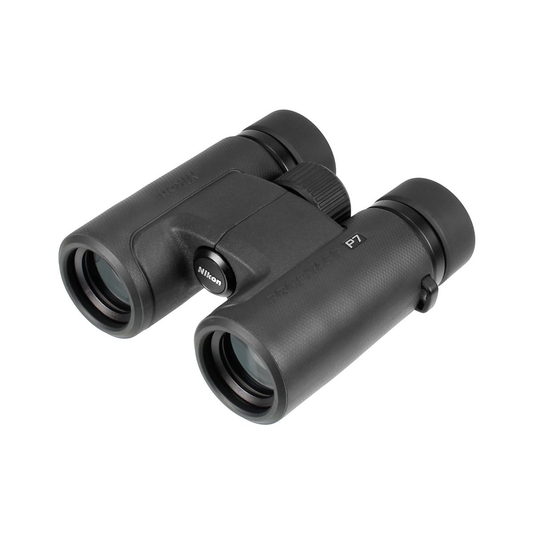

Nikon PROSTAFF P7 10x30 Binoculars deliver sharp, high-resolution images with their multi-coated lenses, ensuring vibrant colors and excellent light transmission. Designed for outdoor enthusiasts, these binoculars provide a generous field of view, making them ideal for birdwatching, hiking, and wildlife observation. The ergonomic rubber armor enhances grip, while the lightweight, waterproof design ensures they withstand various weather conditions. With a locking diopter for personalized adjustments, these binoculars maintain consistent focus for every user.
Constructed with eco-friendly materials free from lead and arsenic, Nikon prioritizes sustainability without compromising on performance. The fiberglass-reinforced polycarbonate body offers robust durability, ensuring these binoculars are ready for rugged adventures. Whether you're camping, at a concert, or spotting distant wildlife, the Prostaff P7 binoculars are built to enhance your outdoor experiences while being easy to carry.
Key Features:
- PEERLESS CLARITY: Multi-coated lenses for high-resolution images in various lighting conditions.
- CUSTOMIZED VIEWING: Locking diopter ring for consistent personalized focus adjustments.
- ROBUST DESIGN: Tough fiberglass-reinforced polycarbonate chassis enhances durability in rugged environments.
- COMFORT GRIP: Rubber-armored coating ensures a secure, non-slip handling experience.
- CONSERVATION FIRST: Eco-friendly glass with no lead or arsenic, supporting environmental consciousness.
- ALL-WEATHER READY: Waterproof and fog-proof features make them suitable for diverse outdoor conditions.
- EASE OF USE: Turn-and-slide eyecups accommodate users with or without glasses for comfortable viewing.
- LIGHTWEIGHT BUILD: Compact design ensures effortless portability for all outdoor activities.
Technical Specifications
| Specification | Details |
|---|---|
| Weight | 16.6 ounces |
| Dimensions: Length | 4.9 inches |
| Field of View | 346 feet @ 1000 yards |
| Objective Diameter | 30mm |
| Product Type | Binoculars |
| Item Condition | New |
| UPC | 018208167715 |
| MPN | 16771 |
What's in the Box?
- Nikon PROSTAFF P7 10x30 Binoculars (16771)
- Eyepiece Cap
- Objective Lens Cap
- Case
- Neck Strap
Customer Reviews
"I took these binoculars on my last hiking trip, and the clarity was outstanding!"
"Perfect for birdwatching! Lightweight and easy to handle."
"I love how they feel in my hands. Great grip and very durable."
FAQ
What makes the Nikon PROSTAFF P7 binoculars suitable for outdoor adventures? Their waterproof and fog-proof design, along with a durable construction, ensures they can withstand various weather conditions. The multi-coated lenses provide excellent optical clarity, making them perfect for wildlife observation or hiking in different environments.
How do I maintain my Nikon PROSTAFF P7 binoculars? Regularly clean the lenses with a soft, lint-free cloth to avoid scratches. Store them in the provided case when not in use to protect against dirt and moisture. Ensure the eyecups and other components are free from debris for optimal performance.
How do the Nikon PROSTAFF P7 binoculars compare to other models? Compared to similar models, the PROSTAFF P7 offers superior optical performance with its multi-coated lenses and wider field of view. Additionally, the ergonomic design and lightweight build make them more comfortable for extended use, especially during outdoor activities.
Similar Models
Looking for more options? Explore our extensive Nikon lineup, including models like Nikon Monarch 5 10x42 for enhanced light transmission and Nikon Aculon A211 10x42 for a classic design. Discover the full collection for top-tier binoculars tailored to your adventures.You May Also Like
Here’s some of our most similar products people are buying. Click to discover trending style.










